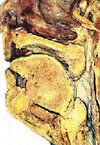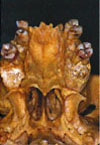by Brian G. Palmer, DDS
It is important to treat all children who have high palates, narrow dental arches, overjets, and obstructed airways as soon as possible in order to reduce the incidence of OSA in the population.
To understand and appreciate obstructive sleep apnea (OSA), one must first understand initial airway development and skull characteristics. Edmund Crelin1,2 was an anatomy professor at Yale for 37 years, and in his research, he explains human embryological and anatomical development. When an infant is born, the relationship between the soft palate and epiglottis is uniquely different from that of an adult. When a newborn’s mouth is closed during quiet respiration, the epiglottis and soft palate touch (Figure 1). During breastfeeding, the epiglottis elevates and divides the isthmus faucium into two canals.3 This allows a newborn to both breathe and swallow at the same time, whereas adults cannot do this. At this stage of life, newborns have an airway more similar to those of other mammals4 rather than to adult humans. Obligate nose breathing is a protective quality for animals, allowing them to drink from a pond and at the same time be able to smell any potential danger. It also allows newborns to breastfeed and breathe at the same even though their neuromuscular pathways have not totally developed or matured. Crelin5 observed that at this stage, the tongue of the human infant is advanced anteriorly and is located entirely within the oral cavity.



Figure 2. Adult dissection. Note that the epiglottis is well separated from the soft palate. The distal one third of the tongue is now the anterior wall of the oropharynx
The maturational descent of the epiglottis and distalization of the tongue occurs around the fourth to sixth month after birth.6 The distal one third of the tongue will then become the anterior wall of the oropharynx. It is during the descent of the epiglottis that the highest rate of sudden infant death syndrome occurs (between the third and fifth month).6 It is at this time that the base of the tongue can fall back and block off the airway. Without a neuromuscular response, an infant could suffocate and die.
After the descent, the adult epiglottis never approaches the same proximity to the soft palate again (Figure 2). The separation of the soft palate and epiglottis7 in the human adult is unique to mammal species. It is because of this unique relationship that any OSA research on animals is obsolete before any research even begins. This separation allows for a characteristic unique to humans, articulate speech.2

Figure 3. The palate is V-shaped and the patient has significant malocclusion.
Kushida et al8,9 have researched the morphometric risk factors for OSA syndrome. These factors include a high palate, narrow dental arches, overjet, large body mass index (BMI), and a large neck. If an individual does not have a large BMI or large neck size, then the predictive factors for OSA are a high palate, narrow dental arches, and overjet. These characteristics are classical signs of a malocclusion or “bad bite.” Most of the narrow maxillae have a V-shaped appearance (Figure 3) with either an edge-to-edge posterior bite relationship or a crossbite, rather than a nicely rounded U shape of individuals with good occlusion. Most overjets indicate a Class II retrognathic (pushed back mandible) malocclusion. A narrow maxilla also indicates the individual has a narrowed posterior nasal aperture (choanae). When the oral cavity and/or the airway collapse, the Venturi and Bernoulli principles10 become more of a factor. Since the roof of the mouth (palate) is also the floor of the nose, then a high palate also infringes on nasal cavity space. The smaller the nasal cavity space is initially, the more difficult it is to surgically increase the chamber size. The smaller the nasal space, the greater will be the resistance to air flow. All of the above infringe on tongue and oral cavity space.

Figure 4. Prehistoric skull with normal palate, wide dental arch, and large posterior nasal aperture. Note the U-shaped arch.

Figure 5. Younger skull (1940s) with a high palate, narrow dental arch, and small, congested posterior nasal aperture.
Skulls
Weston Price, MD,11 traveled the world in the 1930s visiting nonindustrialized islands and cultures. The purpose of his trips was to evaluate the teeth, facial contour, and mouths of the natives. He evaluated thousands of natives and skulls. A fascinating point that Price noted in his evaluation of thousands of skulls (at burial sites) and the mouths of the natives of these societies was that nearly all had ideal occlusions with normal palate height, wide dental arches, and minimal decay (Figures 4 and 5). The prehistoric skulls with wide normal palates also had large posterior nasal apertures (choanae). Since the posterior nasal aperture is the beginning of the collapsible portion of the airway, the larger the beginning of this portion of the airway, the less likely the total airway will collapse.9 A common feature of prehistoric and nonindustrialized cultures is that the only option of nurturing their young is breastfeeding. Those societies do not have access to baby bottles, formulas, or pacifiers.
The Importance of Breastfeeding
Breastfeeding is important for palate and dental arch shape, alignment of the teeth, as well as the development of a correct swallow and orofacial musculature.12,13
Breastfed infants have the best chance of developing an ideal Class I occlusion, normal palates, and wide dental arches. Why is this? At birth, the tongue’s natural position is in an advanced forward position.2,14 The tongue extends over and anterior to the mandibular gum pad (mandible). This anterior positioning of the tongue is needed for the protection of the mother’s breast during breastfeeding. If the tongue cannot extend over the gum pad, as may be the case if an infant is tongue-tied, the bottom side of the breast can be traumatized by the hard gum pad. When the tongue extends over the gum pad, it cushions the breast from this trauma. During breastfeeding, the infant has to latch on to the breast in a way that includes much of the areolar tissue and the nipple. The advanced tongue helps compress the lactiferous sinuses under this area and then with a peristaltic-like motion of the tongue, pushes the milk out of the breast and into the throat.15 A coordinated effort of all the mouth, jaw, and facial muscles takes place during breastfeeding assuring proper development of all these muscles. Other than the initial suck to create a lip seal on the breast, not much suction is needed to express the milk from the breast. Milk flow is aided by the mother’s “let-down” process.
The palate of a newborn/infant is quite soft and malleable. During breastfeeding, and also during a young infant’s normal swallow, the tongue shapes the palate by placing pressure on it. If a person is breastfed and has a normal swallow, the palate will have a good chance of having a normal height and a dental arch that has a nicely rounded U shape.
Prevention
The mid-palatal suture does not fuse until the late teen years. In order to prevent, or at least reduce the risk of OSA in individuals with high palates and narrow arches, it is important to rapidly expand the arch before this line fuses.16 If expansion is done early, then the height of the palate will lower and the pterygoid plates can widen allowing for an increase in the width of the posterior nasal aperture. Once the mid-palatal suture fuses, however, the pterygoid plates will not expand. Once the suture fuses, an osteotomy can be performed to widen the arch, but the surgery will not lower the height of the palate or widen the pterygoid plates.
To treat Class II retrognathic malocclusion and overjet, it is again critical to treat the child at the proper time with orthodontics during the best growth spurt. Once growth is completed, about the only way to correct a Class II malocclusion is a surgical osteotomy.
Conclusion
The airway of the human is unique from all other mammals. This uniqueness allows humans to speak. It also means that any OSA research on animals is invalid before the research even starts. It is important to treat all children who have high palates, narrow dental arches, overjets, and obstructed airways as soon as possible in order to reduce the incidence of OSA in our population.
Because prehistoric skulls have wide palates, good occlusion and large posterior nasal apertures, this article hypothesizes that prehistoric man did not have OSA.
Brian G. Palmer, DDS, was a full time general dentist in Kansas City, Mo, who had a special interest in the cause, prevention, and treatment of obstructive sleep apnea.
References
1. Barsh LI. The origin of pharyngeal obstruction during sleep. Sleep Breath. 1999;3:17-22.
2. Crelin ES. Development of the Upper Respiratory System. Clinical Symposia. Summit, NJ: CIBA Pharmaceutical Co; 1976;28(3).
3. Palmer B. SIDS presentation. Slides 13 and 15. Available at: http://www.brianpalmerdds.com. Accessed December 9, 2002.
4. Palmer B. SIDS presentation. Slides 29-34. Available at: http://www.brianpalmerdds.com. Accessed December 9, 2002.
5. Palmer B. SIDS presentation. Slide 36. Available at: http://www.brianpalmerdds.com. Accessed December 9, 2002.
6. Sasaki CT, Levine PA, Laitman JT, Crelin ES Jr. Postnatal descent of the epiglottis in man. Arch Otolaryngol. 1977;103:169-171.
7. Crelin ES. The Human Vocal Tract, Anatomy, Function, Development, and Evolution. New York: Vantage Press Inc; 1987.
8. Kushida CA, Efron B, Guilleminault C. A predictive morphometric model for the obstructive sleep apnea syndrome. Ann Intern Med. 1997;127:581-587.
9. Kushida CA, Guilleminault C, Ahmed O, Clerk AA, Dement WC. A predictive morphometric model for obstructive sleep apnea. SDDS Report. March 8, 1997.
10. Palmer B. Sleep apnea presentation, Section D, Slides D5 to D17. Available at: http://www.brianpalmerdds.com. Accessed December 9, 2002.
11. Price WA. Nutrition and Physical Degeneration. 6th ed. New Canaan, Conn: Keats Publishing Inc; 1997.
12. Palmer B. The influence of breastfeeding on the development of the oral cavity: a commentary. J Hum Lact. 1998;14:93-98.
13. Palmer B. The significance of the delivery system during infant feeding and nurturing. ALCA (Australian Lactation Consultants’ Association) News. April 1996;7:26-29.
14. Palmer B. SIDS presentation, Slides 7, 9, and 10. Available at: http://www.brianpalmerdds.com. Accessed December 9, 2002.
15. Palmer B. The importance of breastfeeding to total health, Section A, slides A2-A13. Available at: http://www.brianpalmerdds.com. Accessed December 9, 2002.
16. Palmer B. The importance of breastfeeding to total health, Section B, slide B25. Available at: http://www.brian palmerdds.com. Accessed December 9, 2002.